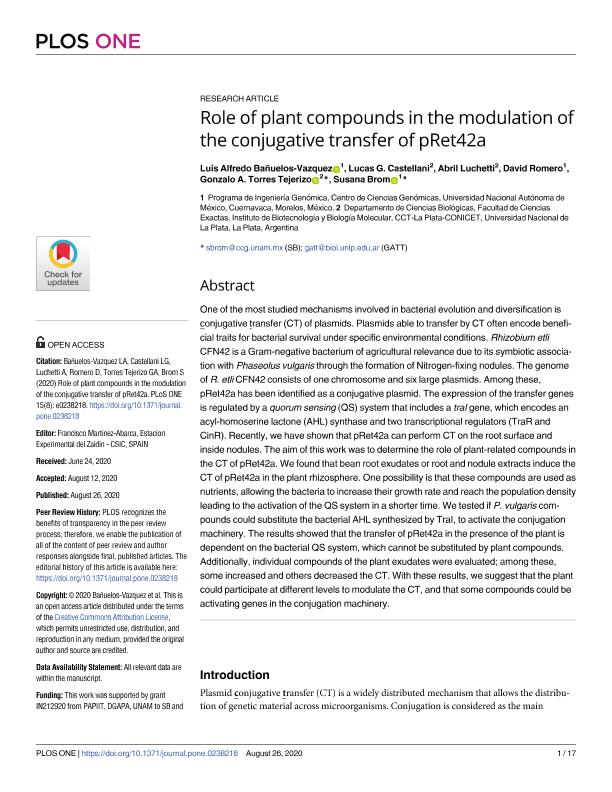Mostrar el registro sencillo del ítem
dc.contributor.author
Bañuelos Vazquez, Luis Alfredo
dc.contributor.author
Castellani, Lucas Gabriel

dc.contributor.author
Luchetti, Abril

dc.contributor.author
Romero, David
dc.contributor.author
Torres Tejerizo, Gonzalo Arturo

dc.contributor.author
Brom, Susana
dc.date.available
2022-12-12T14:00:17Z
dc.date.issued
2020-08
dc.identifier.citation
Bañuelos Vazquez, Luis Alfredo; Castellani, Lucas Gabriel; Luchetti, Abril; Romero, David; Torres Tejerizo, Gonzalo Arturo; et al.; Role of plant compounds in the modulation of the conjugative transfer of pRet42a; Public Library of Science; Plos One; 15; 8-2020; 1-17
dc.identifier.issn
1932-6203
dc.identifier.uri
http://hdl.handle.net/11336/180736
dc.description.abstract
One of the most studied mechanisms involved in bacterial evolution and diversification is conjugative transfer (CT) of plasmids. Plasmids able to transfer by CT often encode beneficial traits for bacterial survival under specific environmental conditions. Rhizobium etli CFN42 is a Gram-negative bacterium of agricultural relevance due to its symbiotic association with Phaseolus vulgaris through the formation of Nitrogen-fixing nodules. The genome of R. etli CFN42 consists of one chromosome and six large plasmids. Among these, pRet42a has been identified as a conjugative plasmid. The expression of the transfer genes is regulated by a quorum sensing (QS) system that includes a traI gene, which encodes an acyl-homoserine lactone (AHL) synthase and two transcriptional regulators (TraR and CinR). Recently, we have shown that pRet42a can perform CT on the root surface and inside nodules. The aim of this work was to determine the role of plant-related compounds in the CT of pRet42a. We found that bean root exudates or root and nodule extracts induce the CT of pRet42a in the plant rhizosphere. One possibility is that these compounds are used as nutrients, allowing the bacteria to increase their growth rate and reach the population density leading to the activation of the QS system in a shorter time. We tested if P. vulgaris compounds could substitute the bacterial AHL synthesized by TraI, to activate the conjugation machinery. The results showed that the transfer of pRet42a in the presence of the plant is dependent on the bacterial QS system, which cannot be substituted by plant compounds. Additionally, individual compounds of the plant exudates were evaluated; among these, some increased and others decreased the CT. With these results, we suggest that the plant could participate at different levels to modulate the CT, and that some compounds could be activating genes in the conjugation machinery.
dc.format
application/pdf
dc.language.iso
eng
dc.publisher
Public Library of Science

dc.rights
info:eu-repo/semantics/openAccess
dc.rights.uri
https://creativecommons.org/licenses/by-nc-sa/2.5/ar/
dc.subject
Gene regulation
dc.subject
Symbiosis
dc.subject
Plasmids
dc.subject.classification
Biología Celular, Microbiología

dc.subject.classification
Ciencias Biológicas

dc.subject.classification
CIENCIAS NATURALES Y EXACTAS

dc.title
Role of plant compounds in the modulation of the conjugative transfer of pRet42a
dc.type
info:eu-repo/semantics/article
dc.type
info:ar-repo/semantics/artículo
dc.type
info:eu-repo/semantics/publishedVersion
dc.date.updated
2021-09-06T17:47:55Z
dc.journal.volume
15
dc.journal.pagination
1-17
dc.journal.pais
Estados Unidos

dc.journal.ciudad
San Francisco
dc.description.fil
Fil: Bañuelos Vazquez, Luis Alfredo. Universidad Nacional Autónoma de México; México
dc.description.fil
Fil: Castellani, Lucas Gabriel. Consejo Nacional de Investigaciones Científicas y Técnicas. Centro Científico Tecnológico Conicet - La Plata. Instituto de Biotecnología y Biología Molecular. Universidad Nacional de La Plata. Facultad de Ciencias Exactas. Instituto de Biotecnología y Biología Molecular; Argentina
dc.description.fil
Fil: Luchetti, Abril. Consejo Nacional de Investigaciones Científicas y Técnicas. Centro Científico Tecnológico Conicet - La Plata. Instituto de Biotecnología y Biología Molecular. Universidad Nacional de La Plata. Facultad de Ciencias Exactas. Instituto de Biotecnología y Biología Molecular; Argentina
dc.description.fil
Fil: Romero, David. Universidad Nacional Autónoma de México; México
dc.description.fil
Fil: Torres Tejerizo, Gonzalo Arturo. Consejo Nacional de Investigaciones Científicas y Técnicas. Centro Científico Tecnológico Conicet - La Plata. Instituto de Biotecnología y Biología Molecular. Universidad Nacional de La Plata. Facultad de Ciencias Exactas. Instituto de Biotecnología y Biología Molecular; Argentina
dc.description.fil
Fil: Brom, Susana. Universidad Nacional Autónoma de México; México
dc.journal.title
Plos One

dc.relation.alternativeid
info:eu-repo/semantics/altIdentifier/url/https://dx.plos.org/10.1371/journal.pone.0238218
dc.relation.alternativeid
info:eu-repo/semantics/altIdentifier/doi/http://dx.doi.org/10.1371/journal.pone.0238218
Archivos asociados
